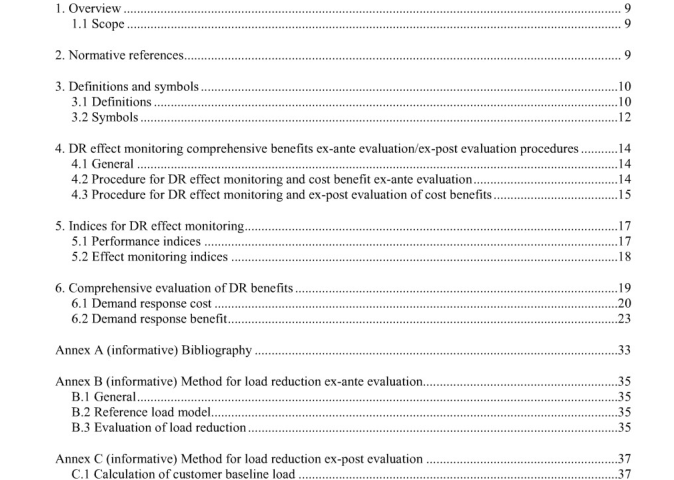IEEE 2030.6-2016 pdf download.IEEE Guide for the Benefit Evaluation of Electric Power Grid Customer Demand Response
4. DR effect monitoring comprehensive benefits ex- ante evaluation/ex-post evaluation procedures
4.1 General
This guide provides the assessment methods for DR effect monitoring and comprehensive cost-benefit ex- ante evaluation/ex-post evaluation. Figure 1 and Figure 2 are the flowcharts showing critical procedures for DR effect monitoring and ex-ante evaluation/ex-post evaluation. The indices of DR effect monitoring are listed in Clause 5.The pre-evaluation/post-evaluation assessment methods for load curtailment are presented in Annex B and Annex C. Clause 6 establishes the system of DR cost benefit indices and the methods to quantify these indices in ex-ante evaluation/ex-post evaluation.
4.2 Procedure for DR effect monitoring and cost benefit ex-ante evaluation
A flow chart for DR effect monitoring and cost benefit ex-ante evaluation is shown in Figure 1.
The procedure of DR effect monitoring and cost-benefit ex-ante evaluation include:
1) establishing a DR evaluation plan;
2) ex-ante evaluation of DR load curtailment;
3) ex-ante evaluation of DR costs and benefits. As shown in Figure 1, to establish the DR evaluation plan, it is necessary to check whether the notification time for dispatch, response duration, and other performance indices of the DR program participants meet the requirements so as to achieve the expected load curtailment, reduced power generation and other targets of the DR program. Clause 5 establishes the associated indices of performance and benefit and defines the corresponding requirements. As shown in Figure 1, the DR load curtailment ex-ante evaluation involves the following critical procedures:
1) establishing reference load calculation model. Based on the analysis of the relationship between historical power consumption data and consumption impact factor, key factors that affect customers’load can be determined, and finally the regression model for reference load calculation is established.
2) predicting the details of events including time (month, working day or not, exact time period), weather conditions (temperature and humidity), and etc.
3) analyzing effects of historical DR events or conducting control experiments to estimate the expected load curtailment.
4) predicting the absolute result of load curtailment which equal to the product of predicted customer reference load and proportion of load curtailment. Annex B gives the description on the methods of load curtailment prediction. As shown in Figure 1, the DR cost-benefit ex-ante evaluation involves the following critical procedures:
1) establishing DR cost-benefit ex-ante evaluation framework to perform effective cost-benefit evaluation for different DR programs and event players.
2) establishing the index system for cost-benefit evaluation (as presented in Chapter 6. 3 of IEC 60050-603) quantifying the evaluation indices.
The procedure of DR effect monitoring and cost-benefit ex-post evaluation include:
1) determining evaluation targets;
2) ex-post evaluation of DR load curtailment;
3) ex-post evaluation of DR costs and benefits. As shown in Figure 2, to determine the ex-post evaluation targets, it is necessary to check whether the response performance of DR resources including the notification time for dispatch, response duration, and other performance indices meet the requirements. By comparing the load curtailment of ex-post evaluation with the expectation, we can verify whether the DR cost-benefit ratio meets the expectation. Clause 5 and Clause 6 establish the associated performance indices, effect monitoring indices and cost-benefit indices to define compliance with the above requirements. As shown in Figure 2, the DR effect monitoring ex-post evaluation involves the following critical procedures:
1) Calculating customer baseline load. Annex C provides the methods for bascline load calculation. Depending upon different customer load characteristics, either daily average method, regression method, or match day method, whichever has the smallest check error, will be used. Also, the baseline will be adjusted based on the forecast weather factors (temperature and humidity) or the load before the event.
2) ex-post evaluation of load curtailment. The actual load curtailment equals to the difference between the customer baseline load and the actual power consumption which can be metered. The DR cost-benefit ex-post evaluation involves the following critical procedures:
l) establishing DR cost- benefit ex-post evaluation framework that can fit different DR programs and event players.
2) establishing the index system for cost-benefit evaluation as presented in Clause 6, and
3) quantifying the evaluation indices. IEEE 2030.6 pdf download.IEEE 2030.6-2016 pdf download
IEEE 2030.6-2016 pdf download

Leave a Reply